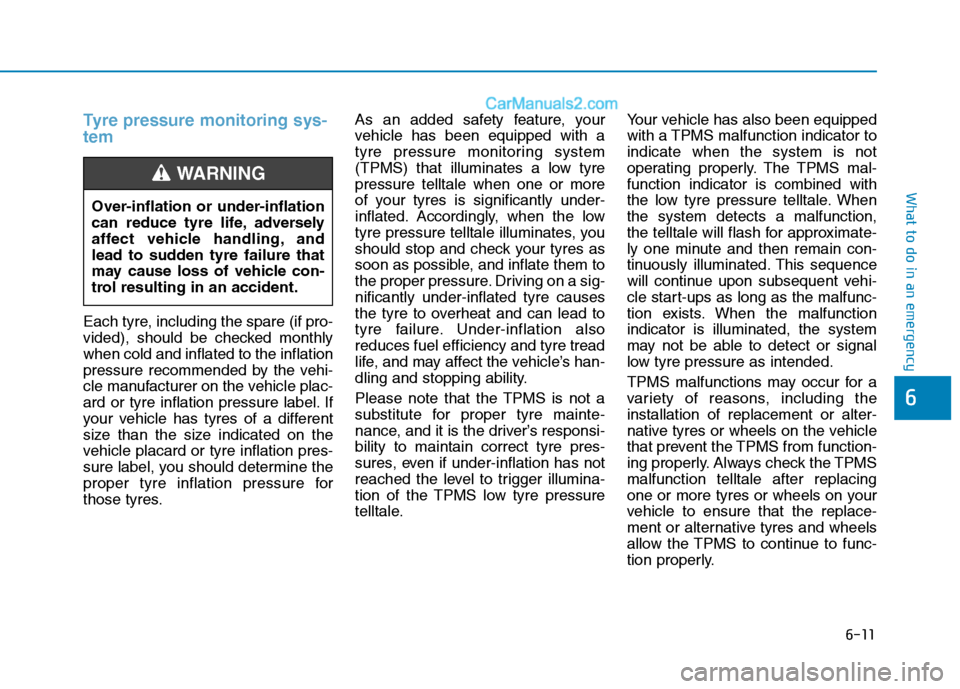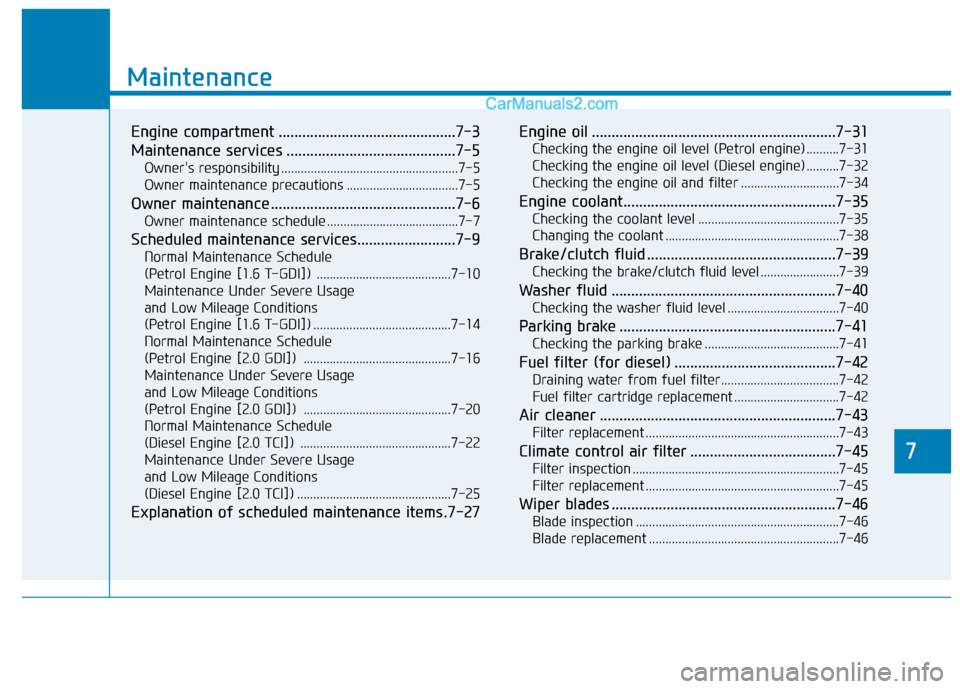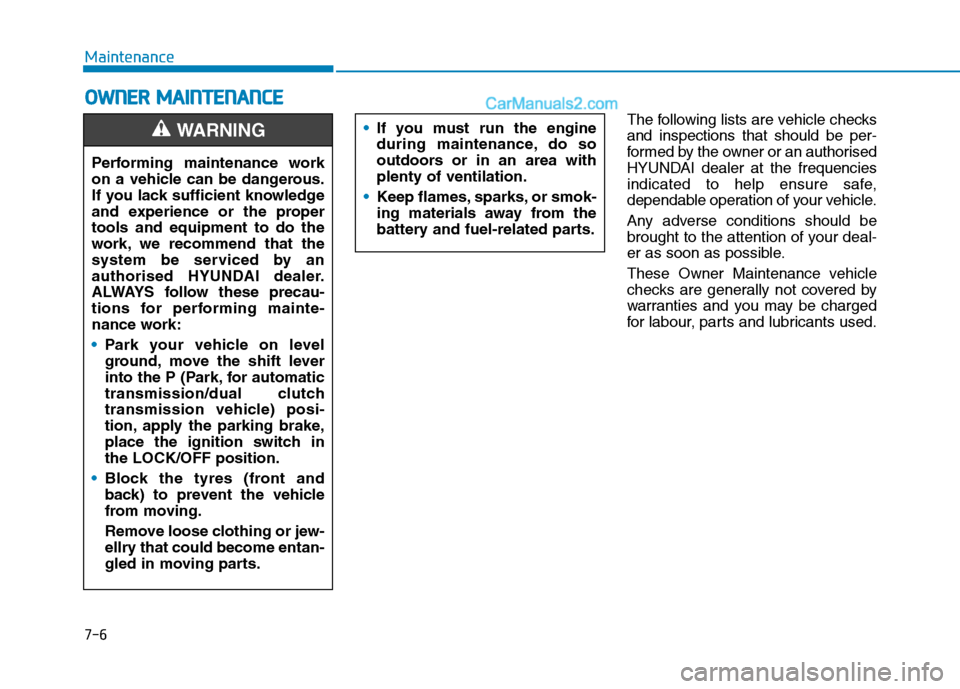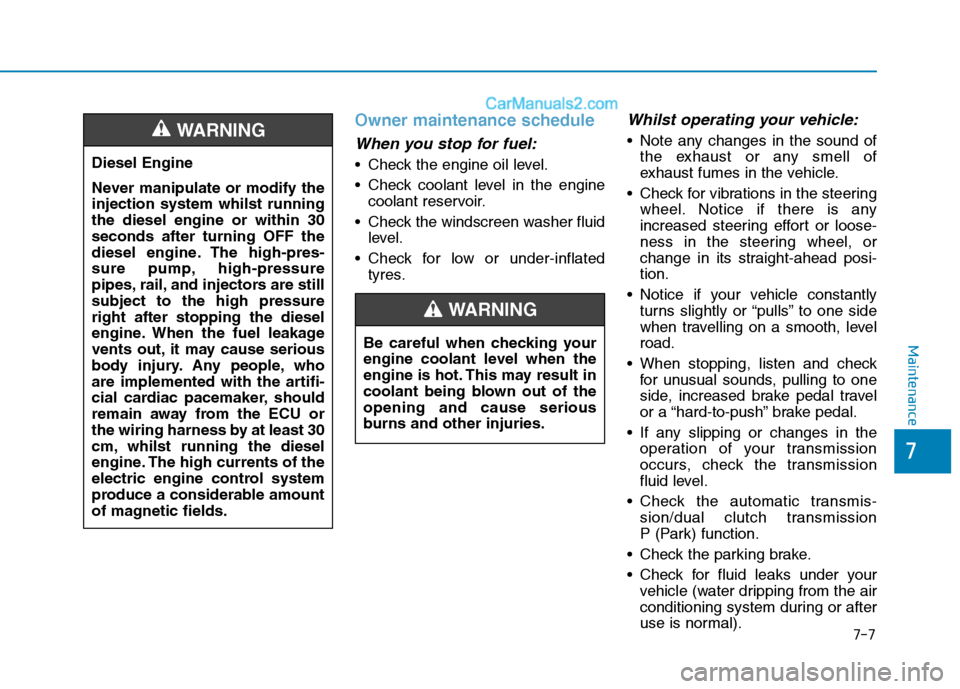2020 Hyundai Tucson fuel
[x] Cancel search: fuelPage 499 of 637

6-11
What to do in an emergency
Tyre pressure monitoring sys-
tem
Each tyre, including the spare (if pro-
vided), should be checked monthly
when cold and inflated to the inflation
pressure recommended by the vehi-
cle manufacturer on the vehicle plac-
ard or tyre inflation pressure label. If
your vehicle has tyres of a different
size than the size indicated on the
vehicle placard or tyre inflation pres-
sure label, you should determine the
proper tyre inflation pressure for
those tyres.As an added safety feature, your
vehicle has been equipped with a
tyre pressure monitoring system
(TPMS) that illuminates a low tyre
pressure telltale when one or more
of your tyres is significantly under-
inflated. Accordingly, when the low
tyre pressure telltale illuminates, you
should stop and check your tyres as
soon as possible, and inflate them to
the proper pressure. Driving on a sig-
nificantly under-inflated tyre causes
the tyre to overheat and can lead to
tyre failure. Under-inflation also
reduces fuel efficiency and tyre tread
life, and may affect the vehicle’s han-
dling and stopping ability.
Please note that the TPMS is not a
substitute for proper tyre mainte-
nance, and it is the driver’s responsi-
bility to maintain correct tyre pres-
sures, even if under-inflation has not
reached the level to trigger illumina-
tion of the TPMS low tyre pressure
telltale.Your vehicle has also been equipped
with a TPMS malfunction indicator to
indicate when the system is not
operating properly. The TPMS mal-
function indicator is combined with
the low tyre pressure telltale. When
the system detects a malfunction,
the telltale will flash for approximate-
ly one minute and then remain con-
tinuously illuminated. This sequence
will continue upon subsequent vehi-
cle start-ups as long as the malfunc-
tion exists. When the malfunction
indicator is illuminated, the system
may not be able to detect or signal
low tyre pressure as intended.
TPMS malfunctions may occur for a
variety of reasons, including the
installation of replacement or alter-
native tyres or wheels on the vehicle
that prevent the TPMS from function-
ing properly. Always check the TPMS
malfunction telltale after replacing
one or more tyres or wheels on your
vehicle to ensure that the replace-
ment or alternative tyres and wheels
allow the TPMS to continue to func-
tion properly.
6
Over-inflation or under-inflation
can reduce tyre life, adversely
affect vehicle handling, and
lead to sudden tyre failure that
may cause loss of vehicle con-
trol resulting in an accident.
WARNING
Page 517 of 637

7
Maintenance
7
Maintenance
Engine compartment .............................................7-3
Maintenance services ...........................................7-5
Owner's responsibility ......................................................7-5
Owner maintenance precautions ..................................7-5
Owner maintenance ...............................................7-6
Owner maintenance schedule ........................................7-7
Scheduled maintenance services.........................7-9
Normal Maintenance Schedule
(Petrol Engine [1.6 T-GDI]) .........................................7-10
Maintenance Under Severe Usage
and Low Mileage Conditions
(Petrol Engine [1.6 T-GDI]) ..........................................7-14
Normal Maintenance Schedule
(Petrol Engine [2.0 GDI]) .............................................7-16
Maintenance Under Severe Usage
and Low Mileage Conditions
(Petrol Engine [2.0 GDI]) .............................................7-20
Normal Maintenance Schedule
(Diesel Engine [2.0 TCI]) ..............................................7-22
Maintenance Under Severe Usage
and Low Mileage Conditions
(Diesel Engine [2.0 TCI]) ...............................................7-25
Explanation of scheduled maintenance items .7-27Engine oil ..............................................................7-31
Checking the engine oil level (Petrol engine) ..........7-31
Checking the engine oil level (Diesel engine) ..........7-32
Checking the engine oil and filter ..............................7-34
Engine coolant......................................................7-35
Checking the coolant level ...........................................7-35
Changing the coolant .....................................................7-38
Brake/clutch fluid ................................................7-39
Checking the brake/clutch fluid level ........................7-39
Washer fluid .........................................................7-40
Checking the washer fluid level ..................................7-40
Parking brake .......................................................7-41
Checking the parking brake .........................................7-41
Fuel filter (for diesel) .........................................7-42
Draining water from fuel filter ....................................7-42
Fuel filter cartridge replacement ................................7-42
Air cleaner ............................................................7-43
Filter replacement ...........................................................7-43
Climate control air filter .....................................7-45
Filter inspection ...............................................................7-45
Filter replacement ...........................................................7-45
Wiper blades .........................................................7-46
Blade inspection ..............................................................7-46
Blade replacement ..........................................................7-46
7
Page 520 of 637

7-4
Maintenance
1. Engine coolant reservoir/Radiator cap
2. Brake/clutch* fluid reservoir
3. Air cleaner
4. Engine oil dipstick
5. Engine oil filler cap
6. Windscreen washer fluid reservoir
7. Fuse box
8. Battery
9. Fuel filter
* : if equipped
OTLE078001RThe actual engine compartment in the vehicle may differ from the illustration.
■ ■Diesel Engine (R 2.0 TCI)
Page 522 of 637

7-6
Maintenance
O OW
WN
NE
ER
R
M
MA
AI
IN
NT
TE
EN
NA
AN
NC
CE
E
The following lists are vehicle checks
and inspections that should be per-
formed by the owner or an authorised
HYUNDAI dealer at the frequencies
indicated to help ensure safe,
dependable operation of your vehicle.
Any adverse conditions should be
brought to the attention of your deal-
er as soon as possible.
These Owner Maintenance vehicle
checks are generally not covered by
warranties and you may be charged
for labour, parts and lubricants used. Performing maintenance work
on a vehicle can be dangerous.
If you lack sufficient knowledge
and experience or the proper
tools and equipment to do the
work, we recommend that the
system be serviced by an
authorised HYUNDAI dealer.
ALWAYS follow these precau-
tions for performing mainte-
nance work:
Park your vehicle on level
ground, move the shift lever
into the P (Park, for automatic
transmission/dual clutch
transmission vehicle) posi-
tion, apply the parking brake,
place the ignition switch in
the LOCK/OFF position.
Block the tyres (front and
back) to prevent the vehicle
from moving.
Remove loose clothing or jew-
ellry that could become entan-
gled in moving parts.WARNING If you must run the engine
during maintenance, do so
outdoors or in an area with
plenty of ventilation.
Keep flames, sparks, or smok-
ing materials away from the
battery and fuel-related parts.
Page 523 of 637

7-7
7
Maintenance
Owner maintenance schedule
When you stop for fuel:
Check the engine oil level.
Check coolant level in the engine
coolant reservoir.
Check the windscreen washer fluid
level.
Check for low or under-inflated
tyres.
Whilst operating your vehicle:
Note any changes in the sound of
the exhaust or any smell of
exhaust fumes in the vehicle.
Check for vibrations in the steering
wheel. Notice if there is any
increased steering effort or loose-
ness in the steering wheel, or
change in its straight-ahead posi-
tion.
Notice if your vehicle constantly
turns slightly or “pulls” to one side
when travelling on a smooth, level
road.
When stopping, listen and check
for unusual sounds, pulling to one
side, increased brake pedal travel
or a “hard-to-push” brake pedal.
If any slipping or changes in the
operation of your transmission
occurs, check the transmission
fluid level.
Check the automatic transmis-
sion/dual clutch transmission
P (Park) function.
Check the parking brake.
Check for fluid leaks under your
vehicle (water dripping from the air
conditioning system during or after
use is normal). Be careful when checking your
engine coolant level when the
engine is hot. This may result in
coolant being blown out of the
opening and cause serious
burns and other injuries.
WARNING
Diesel Engine
Never manipulate or modify the
injection system whilst running
the diesel engine or within 30
seconds after turning OFF the
diesel engine. The high-pres-
sure pump, high-pressure
pipes, rail, and injectors are still
subject to the high pressure
right after stopping the diesel
engine. When the fuel leakage
vents out, it may cause serious
body injury. Any people, who
are implemented with the artifi-
cial cardiac pacemaker, should
remain away from the ECU or
the wiring harness by at least 30
cm, whilst running the diesel
engine. The high currents of the
electric engine control system
produce a considerable amount
of magnetic fields.
WARNING
Page 526 of 637
![Hyundai Tucson 2020 Owners Manual - RHD (UK, Australia) 7-10
Maintenance
Normal Maintenance Schedule (Petrol Engine [1.6 T-GDI])
Months1224364860728496
Km x 1,0001020304050607080
Drive belts *1IIII
Engine oil and engine oil filter *2 *3RRRRRRRR
Intercoole Hyundai Tucson 2020 Owners Manual - RHD (UK, Australia) 7-10
Maintenance
Normal Maintenance Schedule (Petrol Engine [1.6 T-GDI])
Months1224364860728496
Km x 1,0001020304050607080
Drive belts *1IIII
Engine oil and engine oil filter *2 *3RRRRRRRR
Intercoole](/manual-img/35/19693/w960_19693-525.png)
7-10
Maintenance
Normal Maintenance Schedule (Petrol Engine [1.6 T-GDI])
Months1224364860728496
Km x 1,0001020304050607080
Drive belts *1IIII
Engine oil and engine oil filter *2 *3RRRRRRRR
Intercooler, in/out hose, air intake hoseIIIIIIII
Fuel additives *4Add every 10,000 km or 12 months
Air cleaner filterIIIRIIIR
Spark plugs *5Replace every 70,000 km or 84 months
Vapour hose and fuel filler capI
Fuel tank air filter (if equipped)I
Vaccum hose (if equipped)IIIIIIII
I : Inspect and if necessary, adjust, correct, clean or replace.
R : Replace or change.
*
1: Inspect drive belt tensioner, idler and alternator pulley and if necessary correct or replace.
*2: Check the engine oil level for leaks every 500 km or before starting a long trip.
*3: The engine oil level should be checked regularly and maintained properly. Operating with an insufficient amount of oil can dam-
age the engine, and such damage is not covered by warranty.
*
4: If good quality petrols meeting Europe Fuel standards (EN228) or equivalent are not available, using one bottle of additive is
recommended. Additives are available from your authorised HYUNDAI dealer along with information on how to use them. Do
not mix other additives.
*
5: For your convenience, it can be replaced prior to it's interval when you do maintenance of other items.
MAINTENANCE
INTERVALS
MAINTENANCE
ITEM
Page 527 of 637
![Hyundai Tucson 2020 Owners Manual - RHD (UK, Australia) 7-11
7
Maintenance
Normal Maintenance Schedule (Petrol Engine [1.6 T-GDI]) (Cont.)
Months1224364860728496
Km x 1,0001020304050607080
Fuel filter *6R
Fuel line, hoses and connectionsI
Cooling system
In Hyundai Tucson 2020 Owners Manual - RHD (UK, Australia) 7-11
7
Maintenance
Normal Maintenance Schedule (Petrol Engine [1.6 T-GDI]) (Cont.)
Months1224364860728496
Km x 1,0001020304050607080
Fuel filter *6R
Fuel line, hoses and connectionsI
Cooling system
In](/manual-img/35/19693/w960_19693-526.png)
7-11
7
Maintenance
Normal Maintenance Schedule (Petrol Engine [1.6 T-GDI]) (Cont.)
Months1224364860728496
Km x 1,0001020304050607080
Fuel filter *6R
Fuel line, hoses and connectionsI
Cooling system
Inspect coolant level for leaks every day
At first, inspect 40,000 km or 48 months :
after that, inspect every 20,000 km or 24 months
Engine coolant *7At first, replace at 210,000 km or 120 months :
after that, replace every 30,000 km or 24 months *5
All electrical systemsIIIIIIII
Battery conditionIIIIIIII
Brake lines, hoses and connectionsIIIIIIII
Brake pedal, Clutch pedal (if equipped)II
MAINTENANCE
INTERVALS
MAINTENANCE
ITEM
I : Inspect and if necessary, adjust, correct, clean or replace.
R : Replace or change.
*
5: For your convenience, it can be replaced prior to it's interval when you do maintenance of other items.
*6: The fuel filter is considered to be maintenance free but periodic inspection is recommended for this maintenance schedule
depending on fuel quality. If there are some important matters like fuel flow restriction, surging, loss of power, or hard starting
problems etc, we recommend replacing the fuel filter immediately regardless of maintenance schedule and consulting with an
authorised HYUNDAI dealer for details.
*
7: When adding coolant, use only deionised water or soft water for your vehicle and never mix hard water in the coolant filled at
the factory. An improper coolant mixture can result in serious malfunction or engine damage. For your convenience, it can bere-
placed prior to it's interval when you do maintenance of other items.
Page 532 of 637
![Hyundai Tucson 2020 Owners Manual - RHD (UK, Australia) 7-16
Maintenance
Normal Maintenance Schedule (Petrol Engine [2.0 GDI])
Months1224364860728496
Km x 1,000153045607590105120
Drive belts *1IIII
Engine oil and engine oil filter *2 *3RRRRRRRR
Fuel addit Hyundai Tucson 2020 Owners Manual - RHD (UK, Australia) 7-16
Maintenance
Normal Maintenance Schedule (Petrol Engine [2.0 GDI])
Months1224364860728496
Km x 1,000153045607590105120
Drive belts *1IIII
Engine oil and engine oil filter *2 *3RRRRRRRR
Fuel addit](/manual-img/35/19693/w960_19693-531.png)
7-16
Maintenance
Normal Maintenance Schedule (Petrol Engine [2.0 GDI])
Months1224364860728496
Km x 1,000153045607590105120
Drive belts *1IIII
Engine oil and engine oil filter *2 *3RRRRRRRR
Fuel additives *4Add every 15,000 km or 12 months
Air cleaner filterIIRIIRII
Spark plugs *5Replace every 150,000 km or 120 months
Vapour hose and fuel filler capII
Fuel tank air filter (if equipped)II
Vaccum hose (if equipped)IIIIIIII
Fuel filter *6RR
I : Inspect and if necessary, adjust, correct, clean or replace.
R : Replace or change.
*
1: Inspect drive belt tensioner, idler and alternator pulley and if necessary correct or replace.
*2: Check the engine oil level for leaks every 500 km or before starting a long trip.
*3: The engine oil level should be checked regularly and maintained properly. Operating with an insufficient amount of oil can dam-
age the engine, and such damage is not covered by warranty.
*
4: If good quality petrols meeting Europe Fuel standards (EN228) or equivalent are not available, using one bottle of additive is
recommended. Additives are available from your authorised HYUNDAI dealer along with information on how to use them. Do
not mix other additives.
*
5: For your convenience, it can be replaced prior to it's interval when you do maintenance of other items.
*6: The fuel filter is considered to be maintenance free but periodic inspection is recommended for this maintenance schedule
depending on fuel quality. If there are some important matters like fuel flow restriction, surging, loss of power, or hard starting
problems etc, we recommend replacing the fuel filter immediately regardless of maintenance schedule and consulting with an
authorised HYUNDAI dealer for details.
MAINTENANCE
INTERVALS
MAINTENANCE
ITEM